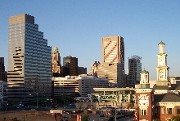Maryland's Jewish Community and Political Demographics
The Baltimore Sun had an article about the political dynamics of Baltimore's Jewish community in the MD-3 Congressional race. I blogged about that article and my own thoughts about that race on Crablaw as well. The following are additional comments beyond those of my Crablaw article.
Most of the bloggers on this site are from Montgomery County, so if you don't know Baltimore County too well, here are the stats. Metropolitan Baltimore's Jewish community is about 110,000, almost exactly the same size as the Jewish community of the Maryland suburbs of DC. An important difference, however, is that the Jewish community in Montgomery and to a lesser extent in Prince George's County is more diffuse. There are synagogues, for example, in Wheaton, Silver Spring, Bethesda, Chevy Chase, Potomac, Rockville, Kensington, etc. While there is a significant Orthodox community in Kemp Mill, the Jewish Community Center for Montgomery County is in Rockville 6 miles away. There is a much smaller but stable Jewish community in the University Park/College Park area and also in Bowie and Greenbelt and Laurel.
By contrast, in Baltimore, 85% of the Jewish community in metropolitan Baltimore lives along two main roads: Reisterstown Road and Park Heights Avenue, on both sides of the City-County line. Those two roads run northwest and parallel for many miles. You can draw a thick magic marker along a line due northwest from where Reisterstown Road and Park Heights Avenue meet at Park Circle all the way out to the cornfields of northwest Baltimore County, and essentially plot the synagogue locations along that line. This is important because two legislative districts in that region have done essentially that: the Eleventh State Legislative District runs along that Northwest Corridor from the City line, and one large segment of MD-3 Congressional does the same, including most of largely Orthodox Jewish community within Baltimore City proper. (Within Baltimore City itself, District 41 had new contours after the 2000 redistricting, becoming more African-American and now has a African-American Senator in Lisa Gladden, who defeated long-time General Assembly veteran Barbara Hoffman in a fairly nasty primary in 2002.)
Ben Cardin, the current occupant of the MD-3 seat, comes from a civic, political and judicial dynasty in Baltimore. Members of his family are prominent attorneys, judges and internationally recognized Jewish philanthropists, human rights activists and civic giants. There is a school
The importance of all of this arises out of the Ehrlich 2002 win. Ehrlich won close and had a lot of support in Baltimore traditionally Democratic Jewish community. But some of that support has eroded and Ehrlich is of course not running against an incompetent campaign this time. O'Malley is quite popular in Baltimore. While my Republican friends tell me that O'Malley is going to get shellacked hard over the education problems in the City during his term as Mayor, most voters in Maryland, I suspect, will view Baltimore not as a problem to be solved, but as a losing no-win scenario to be endured in the manner of Kobayashi Maru of Star Trek, and O'Malley as a guitar-strumming Captain Kirk. But the Jewish community will not support Ehrlich as strongly this time, I suspect, especially with the infamous gaffes of shamed-to-be-one-but-bloody-well-still-is-a-Republican Michael Steele reminding Jewish voters that a Democratic alternative exists.
A contested race for an open seat in MD-3 will engage the Jewish community in NW Baltimore intensely, especially since much of the rest of the district is so sharply gerrymandered into somewhat more Republican - and decidedly non-Jewish - communities in West Arundel and eastern Howard County. That will have a spillover effect in the Jewish communities engagement in other races up- and down-ticket. Unless Albert Wynn somehow loses his primary, there will be little change Montgomery and PG Congressional races this year, and so one would expect less ferment in the suburban Jewish community and generally in both counties. Neither Van Hollen nor Hoyer is facing a meaningful primary to my knowledge.
Most of the bloggers on this site are from Montgomery County, so if you don't know Baltimore County too well, here are the stats. Metropolitan Baltimore's Jewish community is about 110,000, almost exactly the same size as the Jewish community of the Maryland suburbs of DC. An important difference, however, is that the Jewish community in Montgomery and to a lesser extent in Prince George's County is more diffuse. There are synagogues, for example, in Wheaton, Silver Spring, Bethesda, Chevy Chase, Potomac, Rockville, Kensington, etc. While there is a significant Orthodox community in Kemp Mill, the Jewish Community Center for Montgomery County is in Rockville 6 miles away. There is a much smaller but stable Jewish community in the University Park/College Park area and also in Bowie and Greenbelt and Laurel.
By contrast, in Baltimore, 85% of the Jewish community in metropolitan Baltimore lives along two main roads: Reisterstown Road and Park Heights Avenue, on both sides of the City-County line. Those two roads run northwest and parallel for many miles. You can draw a thick magic marker along a line due northwest from where Reisterstown Road and Park Heights Avenue meet at Park Circle all the way out to the cornfields of northwest Baltimore County, and essentially plot the synagogue locations along that line. This is important because two legislative districts in that region have done essentially that: the Eleventh State Legislative District runs along that Northwest Corridor from the City line, and one large segment of MD-3 Congressional does the same, including most of largely Orthodox Jewish community within Baltimore City proper. (Within Baltimore City itself, District 41 had new contours after the 2000 redistricting, becoming more African-American and now has a African-American Senator in Lisa Gladden, who defeated long-time General Assembly veteran Barbara Hoffman in a fairly nasty primary in 2002.)
Ben Cardin, the current occupant of the MD-3 seat, comes from a civic, political and judicial dynasty in Baltimore. Members of his family are prominent attorneys, judges and internationally recognized Jewish philanthropists, human rights activists and civic giants. There is a school
The importance of all of this arises out of the Ehrlich 2002 win. Ehrlich won close and had a lot of support in Baltimore traditionally Democratic Jewish community. But some of that support has eroded and Ehrlich is of course not running against an incompetent campaign this time. O'Malley is quite popular in Baltimore. While my Republican friends tell me that O'Malley is going to get shellacked hard over the education problems in the City during his term as Mayor, most voters in Maryland, I suspect, will view Baltimore not as a problem to be solved, but as a losing no-win scenario to be endured in the manner of Kobayashi Maru of Star Trek, and O'Malley as a guitar-strumming Captain Kirk. But the Jewish community will not support Ehrlich as strongly this time, I suspect, especially with the infamous gaffes of shamed-to-be-one-but-bloody-well-still-is-a-Republican Michael Steele reminding Jewish voters that a Democratic alternative exists.
A contested race for an open seat in MD-3 will engage the Jewish community in NW Baltimore intensely, especially since much of the rest of the district is so sharply gerrymandered into somewhat more Republican - and decidedly non-Jewish - communities in West Arundel and eastern Howard County. That will have a spillover effect in the Jewish communities engagement in other races up- and down-ticket. Unless Albert Wynn somehow loses his primary, there will be little change Montgomery and PG Congressional races this year, and so one would expect less ferment in the suburban Jewish community and generally in both counties. Neither Van Hollen nor Hoyer is facing a meaningful primary to my knowledge.






0 Comments:
Post a Comment
<< Home